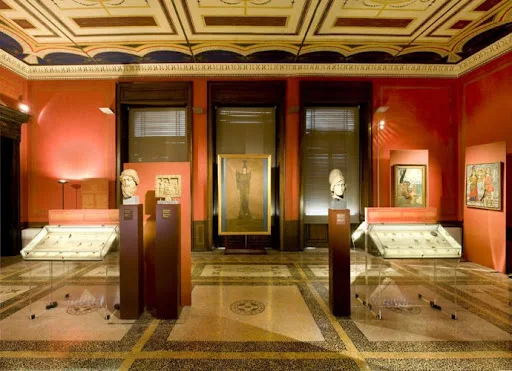Athens the Numismatic Museum
The Numismatic Museum in Athens, founded in 1834, is located in the so-called Illiu Malathron or the mansion of the famous archaeologist Heinrich Schliemann, who discovered the ancient city of Troy. The mansion was the most magnificent private apartments of the city, combining in its design the Renaissance and Neoclassical epochs. Its rooms were decorated with frescoes and mosaics depicting the Trojan War theme. In 1927, the widow of Heinrich Schliemann, Sophia sold the mansion to the Greek state, which first used it as the Council of State, and then as the building of the Cassation Court. Over time, the building was reconstructed and after its complete restoration transferred to the Numismatic Museum.
Schliemann Mansion 1910
The museum has so large collection of coins, medals and various precious stones of different countries and historical periods, that it may be considered one of a kind.
Numismatic Museum facade
For a long time the numismatic heritage of Greece was not widely known. The museum did not even have its own building, and from time to time the small exhibition was transferred to different new premises. Initially the collection was part of the National Library of Greece and was placed in the building of the University of Athens, and then in the building of the Academy of Athens. In 1946 the exhibition was moved to the National Archaeological Museum. Museum became an independent unit in 1965. The true potential of the museum’s collection of treasures was known only to a quite small group of scientists. Thanks to them, the Numismatic Museum in Athens was moved to a new building and in 1999 opened its doors to residents and guests of the city.
Numismatic Museum The Hall
Schliemann Mansion now serves not only as a unique monument of architecture of the 19th century, but also as a place of storage of the unique numismatic collection.
Numismatic Museum
The current exhibition of the museum is not only interesting for its exhibits, but also for their presentation: all the coins are accompanied by a brief abstract. In addition, this wonderful museum offers the lecture in history, dedicated to the ancient Greek coinage. All comers can get small practical lessons of this art directly in the hall of the museum.
Schliemann’s Hall
Acquaintance with the collection begins with Schliemann’s hall, where visitors can see amazingly beautiful tapestries, dedicated to the family of the archaeologist. Scenes on tapestries convey the atmosphere of the time; show the history of the design and construction of the house and other domestic stories.
The next hall of the museum is dedicated to research in the field of numismatics. From the point of view of archeology this hall is the most interesting and intriguing. Here you can see the process of making coins, ancient chasers’ tools, learn about the development of coinage, changing along with the development of the country. Interesting are the stories about the ancient ways of counterfeit. It turns out that even in those days the counterfeit coins existed.
Only in the museum, visitors will see an unusual bronze, which the ancient Greeks used to mint Athenian tetradrachms, depicting an owl. Interesting fact is that these coins were found in Egypt.
The exposition telling about all kinds of options for storing the savings by the ancient Greek citizens is very popular among the visitors. Of course, in ancient Greece there were no deposit boxes, savings accounts and bank cards. So now a small black glazed lamp with the treasure of twelve Athenian silver coins seems naive. Very often wealthy Greeks hid their silver and gold coins in various dishes, which can be seen from the exhibition that shows vases and pitchers with hidden coins.
One of the halls has an exhibition introducing the history of Greek coins in the different regions of Greece. These are the samples, which were issued in Athens, in Macedonia, in the Greek league and union, in Alexandria.
During the excavation of the Korisian cave in France, the scientists found bronze coins, which got there due to the pilgrimage of different dwellers from south and central areas of Greece.
From an artistic point of view, the most beautiful exhibits can be seen in the last hall, devoted to private collections. Many are just masterpieces, as private collections were wealthy Greek numismatic connoisseur of the 19th and 20th centuries. Many of the voluntary donors gave to the museum most of their collections of ancient coins. Here, each coin — is the clearest example of elegance miniature art of Byzantium and Greece. According to the staff of the Museum, this collection of gold and silver coins, representing the great artistic value, cannot be found in any other museum of the modern world. Visitors cannot get their eyes off the elegant and finely carved patterns and inscriptions on the coins.
A complete collection of the museum exhibits contains more than 500,000 copies. It is not surprising that in summer when in Athens there are more tourists than native citizens the museum has to extend the opening hours.
find out more about Greek coins
Numismatic Museum
12 Venizelou (Panepistimiou) Av.,
106 71 Athens, Greece
Telephone: +30 210 3632057, 3612834
Email: nm@culture.gr
7
Website: http://www.nummus.gr
selected hotels near the Numismatic Museum
✔ How to organize your holidays in Athens
Ferry to the islands: Book your ferry to to Santorini, Mykonos and other islands.
Hotels: Discover our selection with the best hotels and accommodation in Athens.
Tours and Activities: Explore the city with some amazing tours and activities.
Car rentals: Discover the the surroundings on your own by booking your car.















